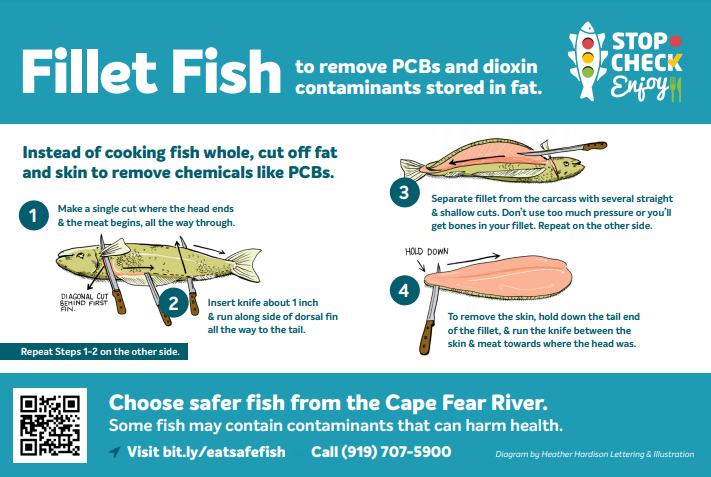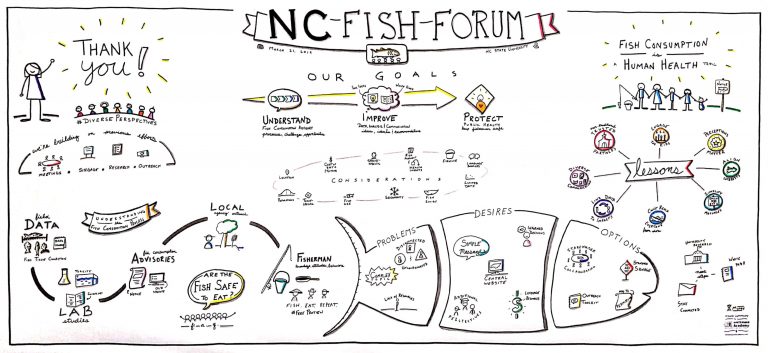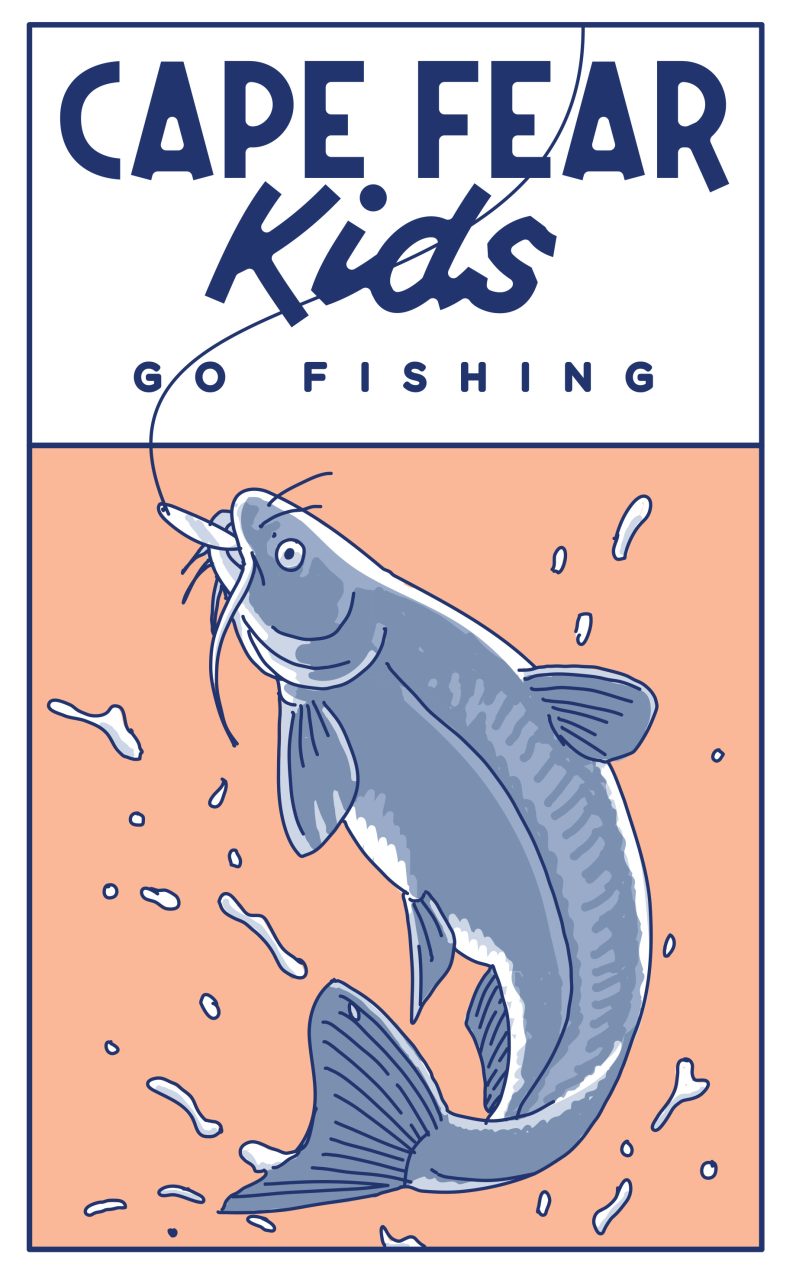Fish provide many dietary benefits as a source of lean protein, omega-3 fatty acids, and other essential nutrients. However, some types of fish can also be sources of harmful contaminants.
You can reduce your exposure to contaminants in fish by choosing safer types of fish and by changing the way you prepare fish.
Check your local fish consumption advisories in your area and limit your consumption of high mercury fish. Some types or sizes of fish may be protected and cannot be eaten. Check catch limits or restrictions for different types of fish. Share consumption advisories and catch limit information with friends and family!
Check Your Local Advisories
- North Carolina Fish Consumption Advisories, NC Department of Health and Human Services
- Fishing Regulations, NC Wildlife Resources Commission

Preparation Tips
- Remove skin and internal organs before cooking the fish. Discard the skin and organs (see diagram above)
- Baking or broiling fish on a broiler tray instead of frying may help to reduce exposure to contaminants in the fish
- Do not use the fat that comes out of the fish during cooking for sauces or other cooking purposes
Check out our 2021-2022 Recipe Calendar for safe and delicious ways to prepare your fish!
Common Fish Contaminants & Health Impacts
Many fish species live in contaminated waters and their bodies may contain chemical contaminants that can be toxic to people. Eating fish that contain contaminants can cause these contaminants to build up in a person’s body. Eating contaminated fish for a long time can increase the risk of illness for adults, but may be especially risky for children and babies because their bodies are still developing.
Depending on the type and amount of contaminants, long-term exposure from eating some types of fish can increase the risk of illness, developmental issues, or, in some cases, cancer. Click on the contaminants below to learn more about specific health effects associated with those chemicals.
Methylmercury
What is methylmercury?
Mercury is a metal that is present in our environment in low concentrations due to both natural and human-related activities. The majority of mercury in our environment is a result of coal burning and mining activities, and is also referred to as inorganic mercury.
Mercury becomes methylmercury when organisms, including some types of soil bacteria, modify the chemical structure of the mercury, creating a more toxic form.
Why is methylmercury a contaminant in fish?
Methylmercury, unlike inorganic mercury, is easily taken into organisms and is capable of building up in the food chain, which is called biomagnification. Often, fish higher on the food chain will have higher levels of mercury in their bodies. Eating fish containing methylmercury is the primary way that most people are exposed.
There is a state-wide advisory in North Carolina for mercury in fish, meaning that people should limit or avoid eating certain types of fish, no matter where they catch them in North Carolina.
What are the health risks associated with methylmercury exposure?
Low-level, long-term exposure from eating contaminated fish has been shown to affect the nervous system and muscle coordination. Children and pregnant women are most at risk from the health impacts of mercury exposure. Mercury exposure during pregnancy may harm the baby and affect normal brain and nervous system development. Young children whose bodies and brains are still growing are also more susceptible to damage from mercury exposure than adults. Even small amounts of mercury can be harmful to children and babies.
PCBs (polychorinated biphenyls)
What are PCBs?
PCBs, or polychlorinated biphenyls, are man-made chemicals which had many historical industrial uses including in electrical and hydraulic equipment, plasticizers, and dyes. Production of PCBs was banned in 1979 because they are hazardous to human and environmental health and do not break down in the environment.
Why are PCBs a contaminant in fish?
Even though the production of PCBs has been banned, they are still found in the environment because they do not break down easily and can travel over long distances from where they were released. They are commonly found in areas where electrical transformers were manufactured and in electronics or metal recycling facilities. When When taken into the food chain, PCBs collect at high levels in the top predator animals (including fish that eat other fish), a process known as biomagnification. They are known to concentrate in the fat and liver of fish and other animals. The fatty tissues inside the fish and also the skin likely contain higher levels of PCBs than other part of the fish. Removing the skin and internal organs before cooking can reduce the amount of PCBs in the fish you eat.
What are the health risks associated with PCB exposure from fish?
PCBs can collect in a person’s fat tissue, and liver, and they can be transferred from mother to baby during pregnancy and also while breastfeeding. Long-term, low level exposure to PCBs is associated with changes in normal immune system function, negative impacts on the nervous system including memory and motor skills, and developmental issues. PCBs are also classified as a probable human carcinogen by the US EPA.
Dioxins (CDDs)
What are dioxins?
Dioxins, and more specifically chlorinated dibenzo-p-dioxins (CDDs), are a group of chemicals that are produced by both natural and human-related processes. Dioxins are not intentionally produced by people, but are an unintended byproduct of industrial activities like incineration (burning fossil fuels and wood, and waste burning), pesticide production, and paper mill bleaching processes.
Why are dioxins a contaminant in fish?
CDDs persist in the environment for long periods of time and are known to build up in the bodies of animals, a process called bioaccumulation, especially in the fat and skin tissues. The most dangerous CDDs are also the most likely to collect at high levels in the bodies of the top predator fish, a process called biomagnification. These CDDs are the most difficult for the animal to break down.
What are the health risks associated with dioxin exposure?
Exposure to low levels of CDDs is linked to changes in immune system and liver function. CDDs are also known to affect normal reproduction and development in animals and possibly in humans. Several types of CDDs are also labeled as a probable human carcinogen by the US EPA.
Hexavalent Chromium
What is chromium?
Chromium is a naturally occurring element that can exist in different forms:
— Trivalent chromium is most common in the environment and is less harmful than hexavalent chromium. This type is healthy for humans in small amounts, and is found in vitamins
— Hexavalent chromium is less common but very toxic to humans. Hexavalent chromium is used for industrial purposes like leather tanning, textile manufacturing, wood preservation, electroplating, and stainless-steel production.
Why is hexavalent chromium a contaminant in fish and crabs?
Unlike some of the other fish contaminants on this list, hexavalent chromium does seem to biomagnify in predator fish, but it can accumulate in bottom feeding fish (like mullet and catfish) or crabs that feed on the bottom of lakes or rivers. In lab tests, hexavalent chromium was shown to accumulate in the skin of the fish at much higher concentrations than in the muscle. So, if there is a chromium advisory in your area, you can reduce your risk by removing the skin of the fish before cooking.
In North Carolina, the Cape Fear River, Brunswick River, and Sturgeon Creek have all had consumption advisories for hexavalent chromium in striped mullet and blue crab.
What are the health risks associated with hexavalent chromium exposure?
Trivalent chromium, the more common form, is a beneficial nutrient in small doses and is not easily absorbed into the body. Hexavalent chromium, however, is a known carcinogen and therefore has no “safe” level of exposure. Exposure to hexavalent chromium through ingestion can increase your risk of developing several health effects including asthma or allergy-like symptoms, stomach ulcers or irritation, anemia, and lung cancer. Long-term exposure to hexavalent chromium may also affect the male reproductive system.
Arsenic
What is arsenic?
Arsenic is a heavy metal which has both natural and human-related sources. Some geographic regions may have naturally high concentrations of arsenic in soils or groundwater. Other sources of arsenic include industrial manufacturing, historical pesticide use, mining, wood treatment, and coal-fired power plants.
Why is arsenic a contaminant in fish and crabs?
Arsenic may accumulate in some fish and also in crabs and other shellfish. The majority (about 93%) of the arsenic in fish is in the less toxic, organic form of arsenic and only about 2 to 4 percent is in the highly toxic inorganic form. Inorganic arsenic is found commonly in drinking water and there are human health standards that regulate arsenic levels in drinking water. There are multiple forms of organic arsenic and the most common, arsenobetaine, is non-toxic to humans. However, smaller amounts of other organic arsenic compounds may have negative health effects. Overall, small amounts of arsenic, either organic or inorganic, can still be harmful.
What are the health risks associated with arsenic exposure?
There is no official “safe” level of arsenic exposure from soil or food for the general population. Increasing your exposure to arsenic can incrementally increase your risk of adverse health effects. Higher levels of exposure to arsenic are associated with several types of skin lesions and cancers as well as adverse impacts on the nervous system, respiratory systems, and heart health. Exposure to arsenic in early life has been associated with altered brain development and increased risk of lung disease later in life.
Why are some contaminants found in fish while others are not?
Not all types of environmental contaminants will accumulate in fish – it depends on many different factors. In general, however, compounds that accumulate in fish have a few things in common:
- They do not breakdown easily in the environment
- Many of them can be carried long distances by air or water away from where there were released
- Some chemicals like PCBs are fat-loving (also called lipophilic) meaning that they dissolve in fats/oils and do not mix well with water, and this makes them more likely to enter and stay in the bodies of animals, including fish
- They are not easily broken down, or metabolized, once they make it inside the body of an organism, and may stay there for a long time.
Community Health Outreach Materials
Are you a community health professional or local organization interested in conducting a safe fish consumption training or outreach campaign in your community?
The following materials were developed by the DUSRC Community Engagement Core in partnership with the Cape Fear River Watch and other community partners for an educational outreach campaign targeted at subsistence fishermen on the Cape Fear River.
Contact us if you need assistance adapting these materials for your region or have questions about dimensions, paper type, etc. needed for printing.
What is social marketing?
Social marketing borrows techniques from traditional commercial marketing campaigns for a social purpose. The approach aims to impact individual behavior by addressing barriers and motivations to behavior change. Social marketing campaigns like “Stop, Check, Enjoy!” are driven by the wants and needs of the public and they aim to change behaviors or ideas for the better.
Social Media Toolkit
The stop, Check, & Enjoy! campaign aims to help people eat safer fish from out of the Cape Fear River. Our social media toolkit is a great way to spread these important environmental health messages to the vulnerable groups that are most impacted by contaminated fish.
A social media toolkit gives anyone the information and resources they need to amplify a social media campaign. Our toolkit aims to spread the messages of the Stop, Check, & Enjoy! campaign — namely eating fish safely from the Cape Fear River.
What are the different parts of our toolkit?
PDF guide: Includes suggested text and hashtags for posts and lays out which graphics go with each campaign message for each social media platform. The guide is also made for both English and Spanish-speaking audiences.
Check out the guide —> English | Spanish
Campaign messages: Our toolkit has four separate campaign messages that touch on different aspects of Stop, Check, Enjoy and eating fish safely out of the Cape Fear River. The PDF guide has samples text and graphics for each of these four messages.
Graphics: Visuals that you can use in your social media posts.
How do I use the toolkit?
- Choose a campaign message that you want to share
- Figure out which social media platform you want to use (Facebook, Instagram, Twitter)
- Download the graphics for that specific campaign message and social media platform (for example, the graphics for campaign message 2 on Facebook)
- When drafting a post, you can use our suggested language, hashtags, and links, or come up with your own! Upload the graphics to the platform
- And post!
- You can also tag us so that we see your post!
Campaign Messages
Campaign Message 1: Mercury in Fish from the Cape Fear River
Download Graphics:
Check https://t.co/ylDH3kJIA9 for info about what’s in your fish, especially if anyone at home is nursing, pregnant, may become pregnant, or is a child under 15. #StopCheckEnjoy #CapeFearRiver pic.twitter.com/J2iOmy5kSV
— Superfund @ Duke (@DukeSuperfund) July 1, 2021
Campaign Message 2: How to Prepare Fish to Avoid Contaminants
Download Graphics:
Fillet fish from the #CapeFearRiver to reduce health risks from pollutants that may be stored in fat. Learn how to prepare safe & healthy fish recipes from local chefs: https://t.co/4qx6a59jeJ (1/3) pic.twitter.com/FMFVY92JKS
— Superfund @ Duke (@DukeSuperfund) July 8, 2021
Campaign Message 3: Proper Serving Sizes of Fish
Download Graphics:
Ppl who are nursing, are/may become pregnant, kids under 15 should avoid catfish + largemouth bass from #CapeFearRiver or any waters in NC due to mercury risk: https://t.co/ylDH3l1jYJ pic.twitter.com/0dbndD7Yzv
— Superfund @ Duke (@DukeSuperfund) July 19, 2021
Campaign Message 4: Eat Smaller, Younger Fish
Download Graphics:
Choose smaller, younger fish when #fishing from the #CapeFearRiver to reduce health risks from mercury.
— Superfund @ Duke (@DukeSuperfund) July 22, 2021
Remember to follow all posted wildlife catch limits!https://t.co/EhL9EbPKCV pic.twitter.com/QM5M2WsPcL
Fish Consumption Advisories
The North Carolina Department of Environmental Quality (DEQ) is the state agency responsible for collecting fish tissue and testing for contaminants. The NC Department of Health and Human Services (DHHS) uses the data on contaminant concentrations to set fish consumption advisories. Fish tissue testing can be requested by the DEQ, by local health departments, or during a public health evaluation at a hazardous waste location.

To set these advisories, NC DHHS uses the fish tissue data along with general information and some assumptions about the types and amounts of fish eaten by the average person, to assess health risk. NC DHHS sometimes take subsistence fish consumers into account as well. If the agency identifies a significant health risk for a group of people as a result of eating certain types of fish, then NC DHHS will issue a fish consumption advisory for that body of water, with corresponding limits to how much of each type of fish can be eaten, each week.
North Carolina Fish Forum

In March 2019, the North Carolina Fish Forum was hosted by UNC-Chapel Hill, North Carolina State University, and the Duke Superfund Research Center Community Engagement Core to bring together stakeholders involved in issuing and communicating Fish Consumption Advisories. Our goal was to discuss opportunities and challenges for improving the fish consumption advisory process in North Carolina.
Resources
- Stop, Check, Enjoy! Campaign Materials
- Stop, Check, Enjoy! 2021-2022 Recipe Calendar
- Mercury in Fish Fact Sheet
- Educating Others About Choosing Safer Fish
- Fish ID Quick Guide
- Mercurio En El Pescado
Other Helpful Resources
- Should I Eat the Fish I Catch? brochure (English) (Español) – US EPA
- Advice about Eating Fish For Women Who Are or Might Become Pregnant, Breastfeeding Mothers, and Young Children – US FDA
- Fish: What Pregnant Women and Parents Should Know – US EPA and FDA
- Mercury: What you need to know – Dartmouth Toxic Metals Superfund Research Program
- Contaminants in Fish – UNC Chapel Hill Superfund Research Program
- Eat Safe Fish” materials from Michigan – Michigan Department of Health and Human Services
Understanding Fish Consumption Advisories
- Current Mercury Advisories by County – North Carolina Department of Health and Human Services
- General Mercury in Fish Advisory for North Carolina – North Carolina Department of Health and Human Services
- What You Need to Know about Eating Freshwater Fish in North Carolina: Fish Consumption Advisories – NC State Center for Human Health and the Environment
FAQs
Why are children & pregnant women more at risk from mercury exposure in fish?
Mercury can affect the development of fetuses and children. Small doses matter; children breathe, eat, and drink more relative to their size than adults. Their bodies and brains are still developing. They also have more skin surface area than adults.
Where can I find current fish consumption advisories for my area?
Visit bit.ly/eatsafefish to find current advisories for the state of North Carolina, by waterbody.
Why does the DUSRC CEC focus on subsistence fish consumers? And what is a subsistence fish consumer?
A subsistence fish consumer is someone who depends on fish as a supplemental source of food (protein) in the diet. He or she regularly consumes fish caught from a local water body. The CEC focuses our efforts on subsistence consumers because they have a higher dose (exposure) to contaminants in fish because they frequently consume fish from local waters that may contain contaminants.
Have a question about contaminants and health?
Contact the ATSDR Information Line: 800-CDC-INFO





